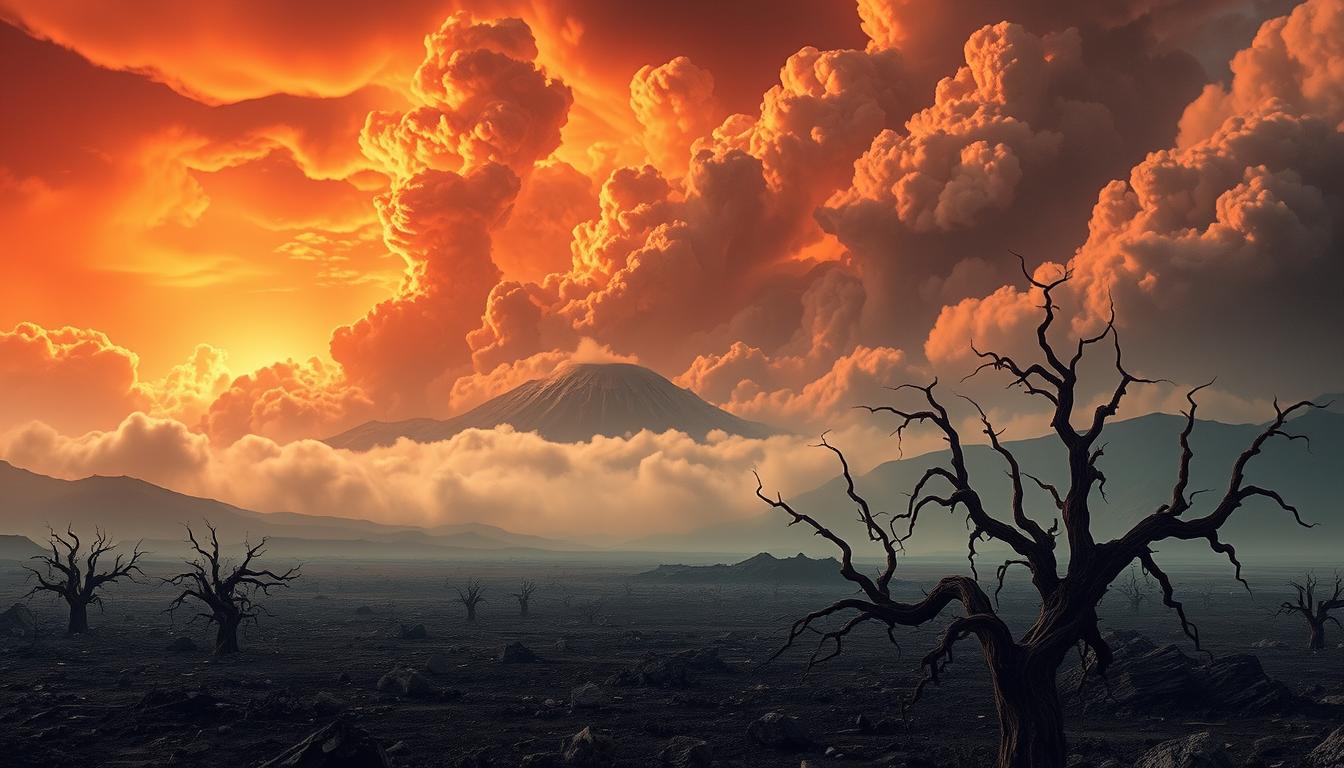Imagine a world vastly different from the one we know today, where ancient creatures ruled the Earth. Long before the mighty dinosaurs roamed, our planet was home to a diverse array of fascinating beings.

The Pre-Dinosaur Era is a captivating chapter in Earth’s history, filled with mysterious and often bizarre life forms that adapted to their environments in remarkable ways.
Exploring this period offers a unique glimpse into the evolution of life on Earth, setting the stage for the eventual rise of the dinosaurs.
Key Takeaways
- Earth’s history is divided into distinct eras, each with unique characteristics.
- The period before dinosaurs was inhabited by a variety of ancient creatures.
- Understanding the Pre-Dinosaur Era provides insights into the evolution of life.
- Ancient life forms were incredibly diverse and adapted to their environments.
- The transition from Pre-Dinosaur Era to the dinosaur era was a significant event in Earth’s history.
The Formation of Earth and Earliest Life
From a hostile, fiery environment to a haven for life, Earth’s transformation is a remarkable journey. The early stages of Earth’s formation and the emergence of its first life forms are crucial to understanding the planet’s history.
The Hadean Eon: Earth’s Fiery Beginning
The Hadean Eon, spanning from approximately 4.5 to 4 billion years ago, was characterized by intense volcanic and tectonic activity. During this period, Earth’s surface was largely molten, with temperatures soaring above 2,000°F (1,093°C).
Formation of Oceans and Atmosphere
As Earth cooled, the formation of oceans and atmosphere began. Volcanic outgassing released water vapor and gases, which eventually condensed to form the oceans. The early atmosphere was devoid of oxygen, consisting mainly of methane, ammonia, and other gases.
The First Single-Celled Organisms
The emergence of single-celled organisms marked a significant milestone in Earth’s history. Archaea and Bacteria were among the first inhabitants of Earth, thriving in primordial environments.
Archaea and Bacteria: Earth’s First Inhabitants
These microorganisms played a crucial role in shaping Earth’s ecosystem. They were capable of surviving in extreme conditions, contributing to the development of a more complex biosphere.
Stromatolites: Living Fossils from the Dawn of Life
Stromatolites, formed by the activities of ancient cyanobacteria, are considered living fossils. They provide valuable insights into the early Earth’s biosphere and the processes that led to the diversification of life.
The study of Earth’s early history and its first life forms offers a fascinating glimpse into the planet’s transformation. Understanding these processes is essential for appreciating the complexity and diversity of life on Earth today.
The Pre-Dinosaur Era: Timeline and Major Periods
Understanding the Pre-Dinosaur Era is crucial for grasping the evolutionary history of our planet. This era, spanning from Earth’s formation to the dawn of the dinosaurs, is divided into significant geological periods that shaped life on Earth.
The Precambrian Supereon (4.6 Billion -541 Million Years Ago)
The Precambrian Supereon, the earliest phase of Earth’s history, witnessed the planet’s formation and the emergence of the first life forms. During this period, Earth underwent significant transformations, including the development of its crust and atmosphere.
The Paleozoic Era (541-252 Million Years Ago)
The Paleozoic Era marked a significant shift with the Cambrian Explosion, where complex life forms rapidly evolved. This era is further divided into six critical periods that played a pivotal role in shaping life before the dinosaurs.
Six Periods That Shaped Life Before Dinosaurs
- Cambrian Period: Known for the Cambrian Explosion, a period of rapid evolution of complex life.
- Ordovician Period: Saw the diversification of marine life and the development of early ecosystems.
- Silurian Period: Characterized by the development of early fish and the colonization of land by plants and animals.
- Devonian Period: Often called the “Age of Fish,” this period saw significant advancements in vertebrate evolution.
- Carboniferous Period: Marked by the development of modern coral reefs and the diversification of amphibians.
- Permian Period: Ended with the most severe mass extinction event in Earth’s history, known as the “Great Dying.”
| Period | Major Events |
|---|---|
| Cambrian | Cambrian Explosion, rapid evolution of complex life |
| Ordovician | Diversification of marine life, early ecosystems |
| Silurian | Development of early fish, land colonization by plants and animals |
| Devonian | Advancements in vertebrate evolution, “Age of Fish” |
| Carboniferous | Development of modern coral reefs, diversification of amphibians |
| Permian | “Great Dying,” most severe mass extinction event |
Key Environmental Changes That Drove Evolution
Significant environmental changes, including the Oxygen Revolution, played a crucial role in driving the evolution of life on Earth.
Oxygen Revolution and Its Impact
The Oxygen Revolution, which occurred during the Precambrian Supereon, marked a critical turning point in Earth’s history. The increase in oxygen levels allowed for the development of more complex life forms, paving the way for the diverse range of species that followed.
The Ediacaran Period: First Complex Organisms
The Ediacaran Period is renowned for its enigmatic biota, representing some of the earliest known complex multicellular organisms on Earth. This period, which lasted from approximately 635 to 541 million years ago, marked a significant turning point in the evolution of life.
Ediacaran Biota: Mysterious First Multicellular Life
The Ediacaran Biota consists of a diverse array of fossilized organisms that were predominantly soft-bodied. These ancient life forms are found in sedimentary rocks around the world and provide crucial insights into the early stages of multicellular life. The Ediacaran Biota includes a variety of morphologically complex organisms that do not fit neatly into modern phyla.
Dickinsonia, Charnia, and Other Strange Creatures
Among the most fascinating Ediacaran fossils are Dickinsonia and Charnia. Dickinsonia, with its quilted, flat body, is one of the most studied Ediacaran fossils, while Charnia is known for its frond-like appearance. These organisms are intriguing not only because of their unusual morphologies but also due to their potential to reveal the early evolution of multicellularity.
Were They Animals, Fungi, or Something Else?
The classification of Ediacaran organisms has been a subject of debate. Some researchers consider them to be early animals or fungi, while others propose that they represent extinct lineages that are distinct from modern kingdoms. The uncertainty surrounding their classification underscores the complexity and mystery of early multicellular life.
The Evolutionary Significance of Ediacaran Life
The Ediacaran Biota played a crucial role in the evolutionary history of life on Earth. These organisms likely paved the way for the development of more complex life forms during the subsequent Cambrian Explosion. Understanding the Ediacaran Biota provides valuable insights into the early evolution of multicellularity and the diversification of life on our planet.
The Cambrian Explosion: When Life Diversified
The Cambrian Explosion marked a pivotal moment in Earth’s history, witnessing an unprecedented diversification of life forms. This event, occurring approximately 541 million years ago, saw the rapid evolution of complex life, setting the stage for the diverse range of species that followed.
Trilobites: The Iconic Cambrian Creatures
Trilobites were among the most iconic and diverse creatures of the Cambrian Period. These arthropods, characterized by their three-lobed body structure, dominated the Cambrian seas. Their fossil record provides valuable insights into the evolution of early life on Earth.
Diversity and Adaptations of Early Trilobites
Early trilobites exhibited a range of adaptations that enabled them to thrive in various environments. Their ability to enroll into a defensive ball and their complex eye structures are examples of their sophisticated evolutionary strategies.
“Trilobites are not just a fascinating group of fossils; they are a window into the early history of life on Earth, showcasing the rapid diversification and adaptation of life during the Cambrian.”
— Dr. Maria Smith, Paleontologist
Anomalocaris and Other Early Predators
The Cambrian seas were also home to formidable predators like Anomalocaris, a large arthropod with powerful grasping appendages. These early predators played a crucial role in shaping the evolution of Cambrian ecosystems.
The Burgess Shale: Window into Cambrian Life
The Burgess Shale fossil site in Canada is renowned for its exceptional preservation of Cambrian life forms. It provides a unique insight into the diversity of Cambrian ecosystems, including the bizarre and enigmatic creatures that inhabited the Earth’s oceans.
Hallucigenia, Opabinia, and Other Bizarre Creatures
Fossils from the Burgess Shale include strange creatures like Hallucigenia and Opabinia, which have puzzled scientists with their unusual morphologies. These organisms highlight the experimental nature of early evolution, where various body plans were tested.
The Cambrian Explosion was a critical period in Earth’s history, laying the foundation for the diversity of life that followed. Understanding this event and its legacy is essential for grasping the broader narrative of life on Earth.
Vertebrate Evolution Before Dinosaurs
Vertebrate evolution before the dinosaurs was marked by crucial milestones that shaped the course of life on Earth. The journey of vertebrates from simple fish-like creatures to complex forms that eventually gave rise to dinosaurs is a fascinating story of adaptation and diversification.
The First Fishes and Jawless Vertebrates
The earliest vertebrates were jawless fishes that appeared during the Cambrian period. These primitive vertebrates, such as Conodonts and Ostracoderms, were characterized by their lack of jaws and paired fins.
Conodonts, Ostracoderms, and Primitive Vertebrates
Conodonts were eel-like creatures with tooth-like structures used for feeding, while Ostracoderms were armored fishes with bony shields protecting their heads and bodies. These early vertebrates played a significant role in the evolution of more complex vertebrate forms.
The Emergence of Jawed Fishes
The development of jaws was a significant innovation in vertebrate evolution, allowing for more efficient feeding and opening up new ecological niches. Placoderms, or armored fishes, were among the first jawed vertebrates and were characterized by their armored heads and thoraxes.
Placoderms and Armored Predators
Placoderms were diverse and included some of the apex predators of their time. Their armor plating provided protection against predators, but it also limited their flexibility and mobility.
The Transition to Land: Tiktaalik and Early Tetrapods
The transition of vertebrates from water to land was a critical step in vertebrate evolution. Tiktaalik, a fish-like tetrapod, represents one of the key transitional fossils showing characteristics of both fish and tetrapods.
The evolution of early tetrapods from fish-like ancestors marked the beginning of a new era in vertebrate history, paving the way for the diversification of amphibians, reptiles, and eventually, dinosaurs.
| Period | Significant Vertebrates | Evolutionary Milestones |
|---|---|---|
| Cambrian | Jawless Fishes (Conodonts, Ostracoderms) | Emergence of First Vertebrates |
| Silurian-Devonian | Jawed Fishes (Placoderms) | Development of Jaws |
| Devonian | Tiktaalik, Early Tetrapods | Transition to Land |
The Age of Amphibians and Early Reptiles
The Carboniferous period marked a significant era in Earth’s history, often referred to as the Age of Amphibians. During this time, amphibians were the dominant vertebrates, thriving in various environments.
Dominant Carboniferous Amphibians
The Carboniferous period saw the rise of diverse amphibian species. Some of the most notable included Eryops and Diplocaulus, which were among the giant amphibians of their time.
Eryops, Diplocaulus, and Giant Amphibians
Eryops, with its robust body and powerful tail, was well-adapted to its environment. Diplocaulus, on the other hand, had a distinctive boomerang-shaped skull. These creatures played a crucial role in the ecosystems of their time.
| Amphibian | Description | Notable Features |
|---|---|---|
| Eryops | Robust body, powerful tail | Adapted for aquatic and terrestrial environments |
| Diplocaulus | Boomerang-shaped skull | Possibly used for defense or display purposes |
The Evolution of the Amniotic Egg: A Revolutionary Adaptation
The development of the amniotic egg was a pivotal moment in vertebrate evolution, allowing reptiles to reproduce on land. This adaptation freed them from the aquatic environments required by amphibians for breeding.

Early Reptile Diversification
As reptiles evolved, they began to diversify into various forms. The earliest known reptiles, such as Hylonomus and Petrolacosaurus, were small and lizard-like.
Hylonomus and Petrolacosaurus: The First True Reptiles
Hylonomus and Petrolacosaurus are considered among the first true reptiles. They exhibited characteristics that would become hallmarks of reptilian evolution, including scaly skin and the ability to lay eggs on land.
The Age of Amphibians laid the groundwork for the rise of reptiles, which would eventually dominate Earth’s landscapes during the subsequent periods.
Synapsids: The Dominant Pre-Dinosaur Land Animals
The pre-dinosaur era was dominated by Synapsids, a diverse group of creatures that paved the way for later life forms. Synapsids were characterized by their mammal-like traits, although they were not directly related to mammals. They were the primary land animals during the Permian and early Triassic periods.
Pelycosaurs: Dimetrodon and Its Sail-Backed Relatives
Pelycosaurs were among the earliest Synapsids, appearing in the late Carboniferous period. Dimetrodon, with its iconic sail on its back, is one of the most well-known Pelycosaurs. This sail, likely used for display purposes, was a distinctive feature.
The Function of the Iconic Sail
The sail on Dimetrodon and its relatives was likely used for thermoregulation or display purposes, such as attracting mates or intimidating rivals. The exact function remains a topic of debate among paleontologists.
Therapsids: The Ancestors of Mammals
Therapsids evolved from Pelycosaurs and were more mammal-like. They were diverse, with some being herbivores and others carnivores. Therapsids gave rise to the first mammals during the Triassic period.
Lystrosaurus: The Disaster Taxon That Survived Mass Extinction
Lystrosaurus, a Therapsid, is known for its ability to survive the Permian-Triassic extinction event. Its widespread presence across different continents makes it a significant fossil find.
Gorgonopsians: The Saber-Toothed Predators of the Late Permian
Gorgonopsians were a group of Therapsids known for their large size and saber-like canine teeth. They were apex predators during the late Permian period, playing a crucial role in their ecosystems.
| Group | Characteristics | Notable Members |
|---|---|---|
| Pelycosaurs | Early Synapsids, some with sails | Dimetrodon |
| Therapsids | Mammal-like, diverse diet | Lystrosaurus |
| Gorgonopsians | Saber-toothed predators | Gorgonops |
The Permian-Triassic Extinction: The Great Dying
Earth’s most severe mass extinction event, the Permian-Triassic extinction, drastically altered the planet’s ecosystem. This catastrophic event, also known as the Great Dying, occurred around 252 million years ago and had a profound impact on the diversity of life on Earth.
Causes of Earth’s Most Severe Mass Extinction
The exact causes of the Permian-Triassic extinction are still debated among scientists, but there is strong evidence that massive volcanic eruptions in the Siberian Traps played a significant role.
Siberian Traps and Global Climate Catastrophe
The Siberian Traps, a large region of volcanic rock, were formed as a result of massive volcanic eruptions. These eruptions released enormous amounts of greenhouse gases, leading to a global climate catastrophe. The resulting global warming and ocean acidification made the environment inhospitable for many species.
The Aftermath and Survivors
The aftermath of the Permian-Triassic extinction was characterized by a significant loss of biodiversity. It’s estimated that 95% of marine species and 70% of land species vanished during this event.
How 95% of Marine Species and 70% of Land Species Vanished
The combination of harsh environmental conditions, including high temperatures and low oxygen levels, made it difficult for many species to survive. The loss of these species had a ripple effect throughout the ecosystems, leading to a prolonged recovery period.
Setting the Stage for Dinosaur Dominance
The Permian-Triassic extinction event paved the way for the rise of new life forms, including the dinosaurs. With many of their competitors and predators gone, the surviving species were able to thrive and evolve into new forms. The image below illustrates the dramatic change in Earth’s landscape after the extinction event.

The recovery of life on Earth took millions of years, but it ultimately led to the diversification of new species, including the dinosaurs, which would go on to dominate Earth’s landscapes for the next 150 million years.
Conclusion: The Legacy of Pre-Dinosaur Life
The Pre-Dinosaur Era is a fascinating chapter in Earth’s history, filled with ancient life forms that paved the way for the diversity of species we see today. From the emergence of single-celled organisms to the complex ecosystems of the Paleozoic Era, this period laid the foundation for the evolution of life on Earth.
Understanding the Pre-Dinosaur Era legacy provides valuable insights into Earth’s history and the processes that shaped our planet. By studying the ancient life forms that dominated this period, we gain a deeper appreciation for the intricate web of life that has evolved over millions of years.
The journey through Earth’s history, from the earliest life to the dawn of the dinosaurs, is a testament to the dynamic and ever-changing nature of our planet. As we continue to explore and learn about the Pre-Dinosaur Era, we are reminded of the importance of preserving and protecting the natural world for future generations.
FAQ
What was the Earth like before the dinosaurs roamed?
Before dinosaurs, the Earth went through significant transformations, starting from a fiery beginning during the Hadean Eon, to the formation of oceans and atmosphere, and the emergence of the first single-celled organisms like Archaea and Bacteria.
What were stromatolites, and why are they significant?
Stromatolites are living fossils from the dawn of life, created by ancient microbial communities. They are significant because they provide insights into the early life on Earth and the conditions that supported it.
What was the Ediacaran Biota, and what did it consist of?
The Ediacaran Biota refers to the first complex, multicellular organisms that emerged during the Ediacaran Period. It consisted of enigmatic creatures like Dickinsonia and Charnia, which are still debated among scientists regarding their classification.
What was the Cambrian Explosion, and why was it significant?
The Cambrian Explosion was a pivotal event in Earth’s history that saw a rapid diversification of life, resulting in a wide variety of complex life forms, including the iconic Trilobites and early predators like Anomalocaris.
What were Synapsids, and why were they important?
Synapsids were a group of animals that dominated land before the dinosaurs. They included Pelycosaurs like Dimetrodon, Therapsids, which were ancestors of mammals, and Gorgonopsians, saber-toothed predators of the Late Permian.
What caused the Permian-Triassic extinction, also known as the Great Dying?
The Permian-Triassic extinction was caused by a combination of factors, including massive volcanic eruptions known as the Siberian Traps, which led to a global climate catastrophe, resulting in the loss of 95% of marine species and 70% of land species.
How did the Permian-Triassic extinction event pave the way for dinosaur dominance?
The Permian-Triassic extinction event cleared the ecological niches, allowing the surviving species, including early dinosaurs, to evolve and eventually dominate Earth’s landscapes.
What were the first vertebrates, and how did they evolve?
The first vertebrates were jawless fishes, followed by the emergence of jawed fishes, including armored Placoderms. Vertebrates then transitioned to land with the evolution of Tiktaalik and early tetrapods.
What was the significance of the amniotic egg in evolution?
The amniotic egg was a revolutionary adaptation that allowed vertebrates to reproduce on land, marking a significant milestone in the evolution of life on Earth.




